
by Mark Smiley | Sep 29, 2014 | General Featured
by Mark Smiley
It is the fastest, coolest, most beautiful trike in the history of trikes and it turns out that it is perfect for community policing according to the Glendale Police Department. The Department has already purchased and is employing one of these beautiful vehicles in day-to-day police work. It’s called a Can-Am Spyder Roadster and it goes up to 125 miles per hour and performs 0-60 mph in just 4.5 seconds.
The three-wheeled motorcycle is manufactured by Canadian company Bombardier Recreational Products better known for their work with snowmobiles and jet skis. The vehicle has a single rear drive wheel and two wheels in front for steering, similar in layout to a modern snowmobile. In fact, it rides more like an ATV or snowmobile rather than a typical motorcycle. The futuristic-looking three-wheeled vehicle, equipped with state-of-the-art radar and camera systems, has been on the prowl since April. More are on the way.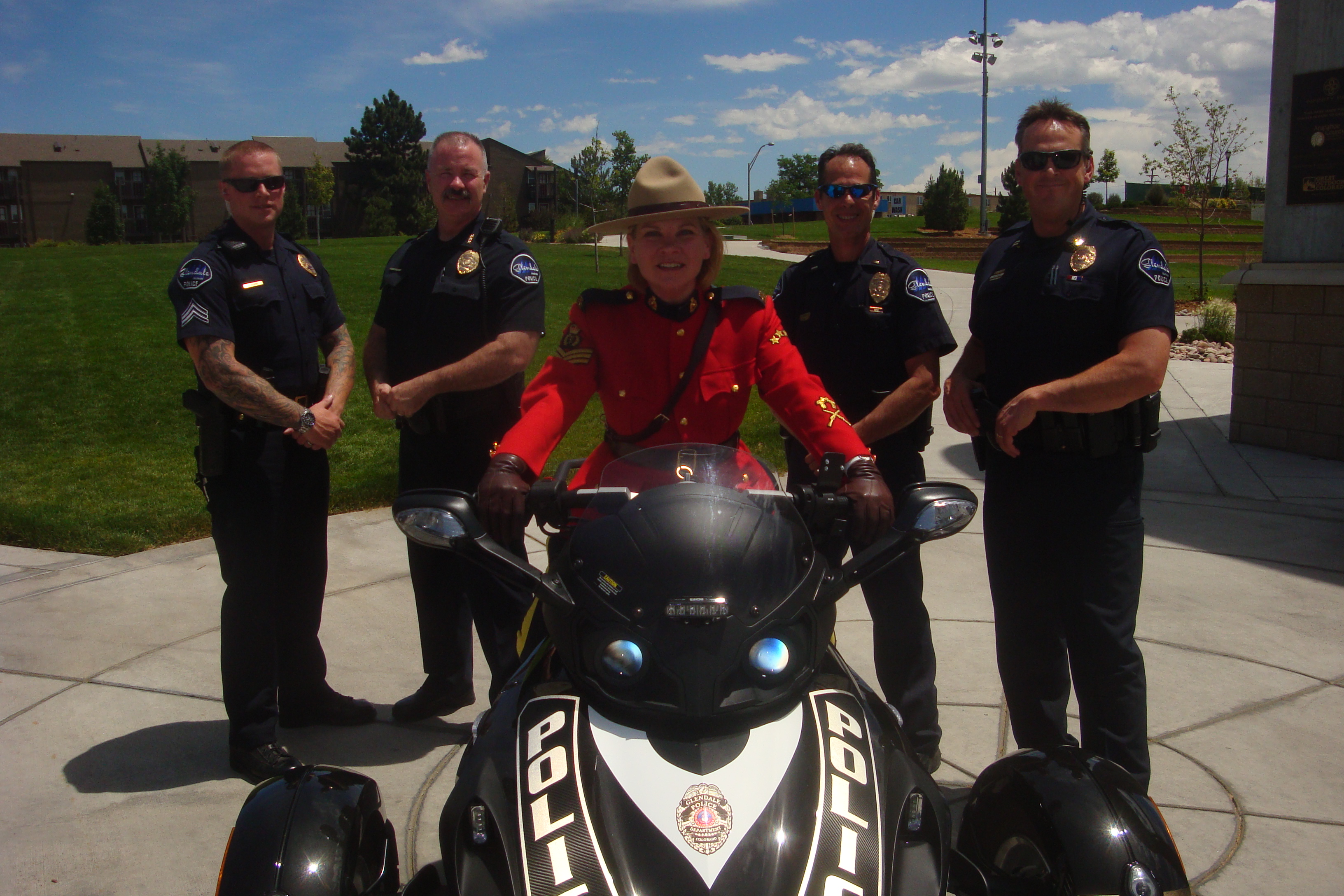
Residents love to stop Glendale police officers riding the Can-Am Spyder to admire the vehicle and talk about its attributes. Just don’t call the vehicle a “trike” to an officer’s face as the Glendale Police are a little touchy about what they deem is a pejorative word for their pride and joy.
With the Riverwalk concept on the horizon (now known as Glendale 180), Captain Mike Gross looked for alternative ways to patrol the area which will be heavily pedestrian. The department has bicycles in its fleet but needed something faster that could still maneuver through tricky terrain, especially from Colorado Boulevard to Cherry Street. After testing a variety of different modes of transportation including electric motorcycles and segways, Gross found a rental company in Sheridan that had the Can-Am Spyders.
The time required to train the officers in the operation of the vehicles is less than traditional motorcycles. The training is held at the Arapahoe County Sheriff’s track. The motorcycle license endorsement is still required in order to ride these new vehicles. “This gives us an alternative to a patrol car,” said Chief William Haskins, Glendale Police. “We train our officers in one half day as opposed to the two weeks of motorcycle training.”
The normal two-wheel motorcycle became a hazard to police officers in Glendale. Approximately 50 percent of officers going through the two-week training would “graduate” and become certified. Chief Haskins points out that shorter statured officers could not place their feet firmly on the pavement with the motorcycles. A fair amount would sustain injuries that would shelve them for an indefinite period of time. In contrast the anti-lock braking system allows the Spyder to stop on a dime making it safer for officers to ride.
The Police Department has sold its last motorcycle and you will not find any more on the streets. Currently, there are 27 sworn in officers on the force and 23 of them are eligible to ride the new Spyder.
Glendale is the only police department to have such a vehicle in Colorado, and is one of only a handful in the entire country to utilize them. Branson, Missouri, has two in their fleet and they are the only department in Missouri with them. The police chief in Branson, Kent Crutcher, says the vehicles “offer better stability on the hills of Branson, and better safety ratings than traditional two-wheeled motorcycles.” Glendale’s police chief’s main focus and mantra is to “take officers out of the metal box and have them be more approachable.”
“O.K., O.K.” Police Chief Haskins conceded at the end of the Chronicle interview. “If you want to call it a ‘trike’ you can call it a ‘trike.’” He went on to explain, “It was Shakespeare who correctly noted in Romeo and Juliet that a rose by any other name still smells just as sweet.”

by Mark Smiley | Sep 29, 2014 | Main Articles
Frontier Renewal Will Finish Environmental Cleanup And Prepare The Site For Development
by Mark Smiley
 Denver-based Frontier Renewal closed on September 12, 2014, on the purchase of over 41 acres at the site of the former Gates Rubber Plant in Denver. The plant has been closed since 1991 with buildings on site ranging in date from 1918 through the 1950s. Frontier Renewal will finish the remediation and cleanup work, as well as prepare the site for vertical development.
Denver-based Frontier Renewal closed on September 12, 2014, on the purchase of over 41 acres at the site of the former Gates Rubber Plant in Denver. The plant has been closed since 1991 with buildings on site ranging in date from 1918 through the 1950s. Frontier Renewal will finish the remediation and cleanup work, as well as prepare the site for vertical development.
The Gates site includes three land parcels: the Broadway Parcel is 15.2 acres between the I-25 and Broadway light rail station and Mississippi along the west side of Broadway. The Santa Fe Parcel is 24 acres between I-25 and Mississippi Ave. along the east side of Santa Fe. The Vanderbilt Park Parcel is 2.5 acres between Tennessee and Vanderbilt Park along the west side of Santa Fe.
On October 1, 1911, Charles Gates Sr. purchased the Colorado Tire and Leather Company located in Denver, Colorado, beside the South Platte River. He paid $3,500 for a property that would one day become one of the world’s largest manufacturers of power transmission belts and a leader in hydraulic and fluid power products for industrial and automotive products. In 1919, the International Rubber Company changed its name to the Gates Rubber Company, and operated at the site from 1937 through 1991.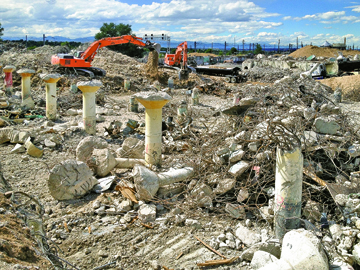
While at first a small enterprise producing “durable treads” made of leather intended to extend the life of the average automobile tire, the company quickly grew and in 1914 produced its first rubber tread. The growth that followed necessitated a new facility and the site at 999 S. Broadway was selected because of its relative proximity to downtown and because it was adjacent to the streetcar line and the railroad tracks, essential for the national distribution of Gates’ products. At the time south Broadway was still a dirt road and considered “suburban.” In the following five years the company added a warehouse, machine shop and more factory space. Growth continued through nearly the rest of the century, with increasing focus on international expansion. In 1995 the era of family-ownership ended when Gates became a wholly-owned subsidiary of Tompkins PLC, a London-based firm. While manufacturing no longer takes place in Denver, Gates continues to operate with its corporate headquarters in Lower Downtown.
In 2001, Cherokee Denver purchased the south Broadway property and created plans for mixed-use development. Cherokee investigated whether some preservation could be accomplished, but due to the unusual circumstances of the contamination, preservation was never guaranteed or promised. Ultimately the Denver City Council-approved General Development Plan did not include preservation elements, and in the aftermath of the 2008 economic crisis the Cherokee deal died and Gates reacquired the site.
Three years later, in 2012, Gates secured Certificates of Non-Historic Status, which are precursors to demolition permits. After months of controversy, a Denver City Council subcommittee voted, in September 2012, to halt efforts to consider the crumbing manufacturing plant one of the city’s historic landmarks. This action was despite a University of Colorado Boulder student asking the city to consider the buildings historic, a designation that would have prevented demolition.
In 2012, Eugene Elliott, presented the Denver Landmark Preservation Commission with a non-owner application and $250 filing fee to grant landmark status to the three oldest remaining structures: the manufacturing plant, known as Unit 10, plus the power plant and warehouse to the north of it. “The former Gates Rubber Company is a huge piece of Colorado and, more relevantly, Denver history,” Elliott said. “By not accepting the landmark-designation application, the owner will proceed to demolish the last remaining physical reminder of what Gates Rubber Company did and was for this city and its citizens.”
The application was denied. Council members cited the need to remove pollution buried under the old plant, and the desire of neighborhood groups living near the building to see it removed, as reasons for their votes. A few months later, the Denver City Council made changes to the city’s landmark ordinance and on December 4, 2012, the Department of Community Planning and Development raised the landmark application fee from $250 to $875. Some say this is to discourage people like Elliott from submitting applications to attempt to stymie the progress of developers.
Also in 2012, Historic Denver, a non-profit historic preservation organization located at 14th and Ogden, coordinated neighborhood meetings to encourage community input. As part of this discussion both Historic Denver and Gates brought forward ideas for consideration.
While many at the meeting were comfortable with the demolition plans, they also expressed great interest in the preservation of the Water Tower. The tower now sits on the ground on the west side of the property, but it was once the most iconic feature of the facility, defining the city’s skyline for South Denver.
As part of the conversations Gates had agreed to retain the Water Tower and keep it in a safe place on the property until plans can be made regarding its reuse, in total or in pieces, somewhere on the site or on adjacent public land, such as the RTD Light Rail Station. Historic Denver believes that the incorporation of this piece would contribute significantly to maintaining an authentic sense of place at the site.
Annie Levinsky, executive director of Historic Denver, said last year that she’d always hoped that the buildings could be saved. “We recognize that the contamination issues are a serious complication,” Levinsky said. “But we’ve always remained hopeful that they could be salvaged.” There is no word yet as to whether Frontier Renewal will retain the Water Tower for the planned development.
Denver Councilman Chris Nevitt, who represents the area, said in September 2013
that he held out hope that a developer might be able to use some of the buildings, but he added that his constituents are eager to see the old factory removed. As proven in 2012 with Elliott’s crusade, not everyone agreed with Nevitt. In September 2013, Gates secured demolition permits for the existing site. The original factory sat deserted on the corner of Broadway and Mississippi until November 2013, when demolition of the final factory buildings began.
Frontier Renewal will now prepare the site for future development. Frontier Renewal will maintain the existing ground water remediation system and will continue cleaning up the remaining contaminates. Frontier Renewal will also work with the City and County of Denver and take part in a community process to discuss the future of the site as Gates did in 2012. Once this work is complete, individual land parcels will be sold for vertical development. Renderings have not yet been submitted but it is widely speculated that the land will be used for apartments or condominiums.
“We are pleased to be selling this important property to a company with the skill and commitment to responsibly manage the environmental risks and ensure that the property is put to beneficial reuse in a manner that will make Gates, the City and other stakeholders proud,” said Tom Reeve, Executive Vice President and General Counsel, Gates Corporation.
“We are thrilled to be acquiring the former Gates site,” said Eric Williams, Chief Executive Officer, Frontier Renewal. “This project is a perfect fit for Frontier Renewal’s strengths: environmental clean-up, real estate development and public-private partnerships. And as Denver natives, we know the importance of this site in Denver’s history. We are looking forward to working with the city and community to create a bright new future for the site.“
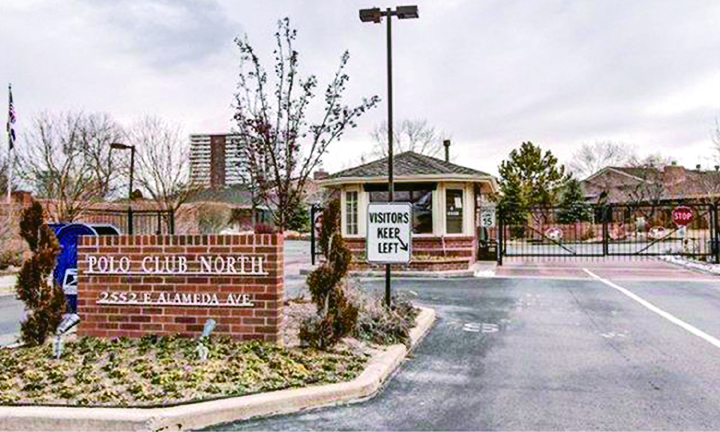
by Mark Smiley | Sep 29, 2014 | Main Articles
$500 Fine For Cars On Driveway Overnight
by Glen Richardson
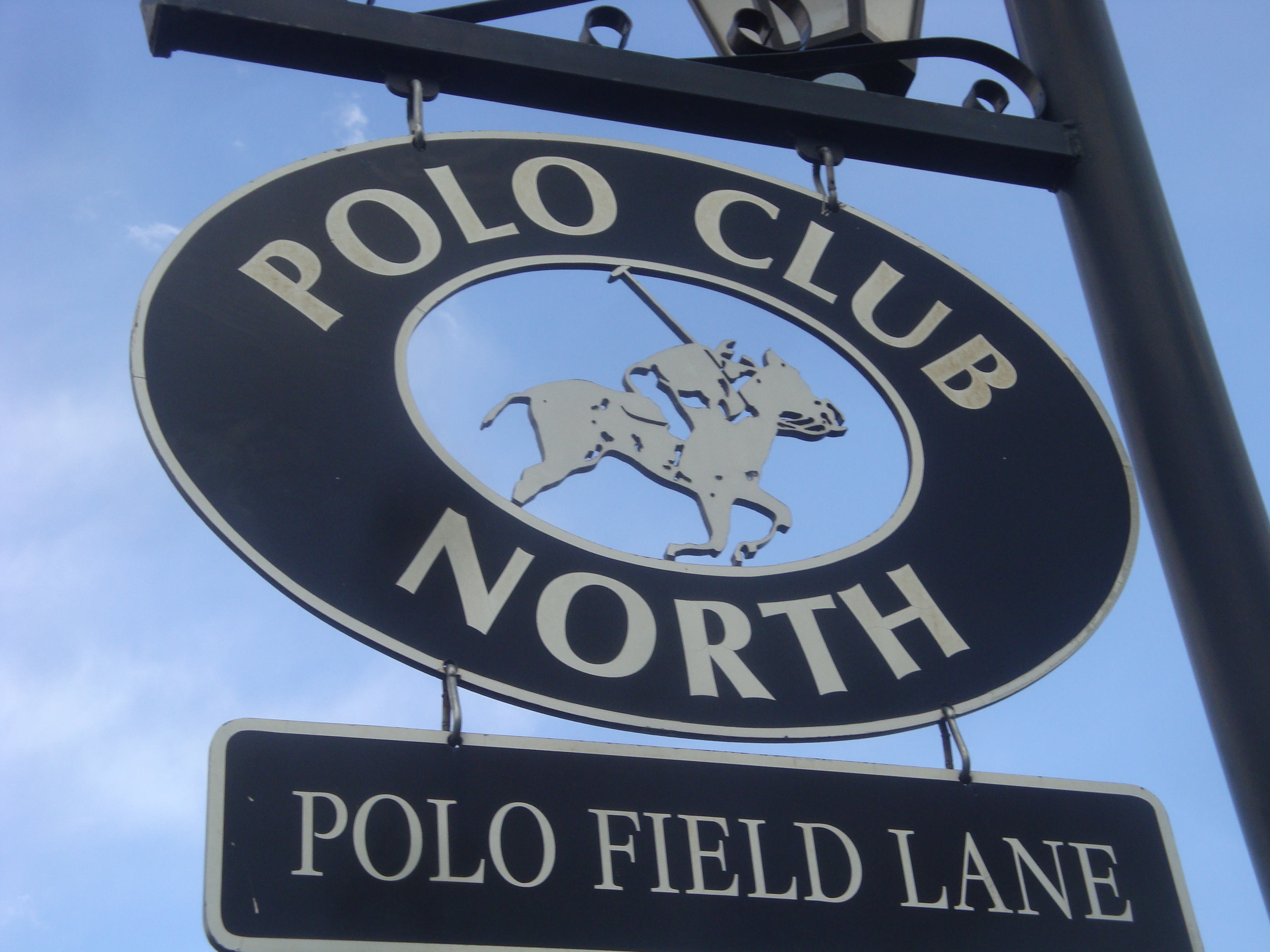
Polo Club North is a gated community with winding streets, open spaces with a stream, small ponds and waterfalls flanked by evergreens and aspens at South University Boulevard and East Alameda Avenue. A clubhouse contains an indoor swimming pool and outdoor tennis courts. Polo ponies cantered over the terrain here at one time. Owners paid immense sums to have garages instead of stables in this converted polo field. But the subject of automobiles has the well-to-do neighbors at each others throats with threats of lawsuits in the air.
The HOA Rules Committee in Polo Club North has proposed an astonishing new rule: To ban resident cars from being left in driveways overnight. The Committee attached a fine of $500 per violation after the second night. The HOA board looked poised to adopt the rule at a board meeting on September 23. However, due to outrage from occupants, the package of proposed rules changes was returned to the Rules Committee for additional deliberation.
John Leather who is helping to lead the opposition told the Chronicle, “If the sample of public opinion delivered at the meeting meant anything to the Rules Committee members present, they will drop the enforceable structure.” In addition to potentially major penalties, owners also worry that the rule would impair the marketing of Polo Club North homes to families, especially those with three cars. According to the Denver Neighborhood News the average sales price of a home in Polo Club area is just under $1.9 million.
Property Rights
In the apparent opinion of the members of the Rules Committee automobiles in driveways are a visual blight to their community. Automobiles are not allowed to be parked overnight on the private roads of Polo Club North. The opposition believes that the Rules Committee’s view of aesthetics is excessive and overblown with one irate homeowner blasting the Board declaring, “We are a community, not a commune.” Moreover, opposition owners believe these pad plazas or driveways are their property; and use of a driveway is a property right.
Upshot: In their view taking away the use of the driveway is taking away property. That, they argue would violate the Colorado Constitution. The HOA Rules Committee has three Colorado lawyers among its seven members, however, and apparently finds no role or weight for Section 14 of the Colorado Constitution’s Bill of Rights as it applies to private condemnation of a property’s use and benefit.
Section 14 states: “Private property shall not be taken for private use unless by consent of the owner, except for private ways of necessity, and except for reservoirs, drains, flumes or ditches on or across the lands of others, for agricultural, mining, milling, domestic or sanitary purposes.” None of those constitutional exceptions apply to the driveway ban, opponents believe.
Whether or not the constitutional exceptions apply, concerned neighbors note that a resident with a two-car garage — most everyone — but with three cars would immediately be impacted, and they will have to run fast from the $500 nightly hit. Ditto anyone with a vehicle too big to fit in the garage, or who has two cars but has used one bay of the garage for a workshop or other use. As one homeowner told the Chronicle, “The driveway use restriction can no more be justified than telling me I cannot use my patio after 9 p.m. Where is the HOA’s authority for taking part of either limited common element?”
Matter Of Beauty
A few residents — and rumor has it that at least one Board member — believe the Committee should consider restricted driveway use as a matter of “beautifying” the community, similar to use of no-plastic-patio-furniture. These beautification proponents say all aspects of driveway parking personally offend them.
“Thus far the Rules Committee is also clinging to the notion an overnight resident parking ban is without legal significance, and entirely defensible because its members think the result will look better,” stated opposition leader Leather.
The opposition also blasted the HOA board for limiting the hearing on the entire matter to only 15 minutes. They claim it was a rush to judgment to prevent discussion and debate.
There is no date set by the HOA Board for a re-hearing on the matter.
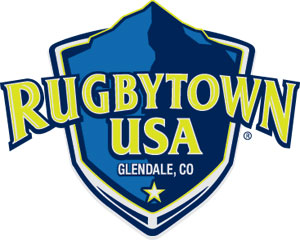
by Mark Smiley | Sep 29, 2014 | Glendale City News
by Marco Cummings
Writer for and on behalf of the City of Glendale

Casey Rock
The Glendale Raptors fell short of their summertime goals in 2014, falling a game short of Club 7s Nationals with a loss at the Omaha 7s qualifying tournament and falling short of hardware with a loss to the Northeast Olympic Development Academy with a 35-7 loss in the Plate (second tier) Final at the annual Serevi RugbyTown Sevens tournament hosted at Infinity Park.
Yet neither defeat was the biggest blow to the Raptors during a grueling 7s season. The team’s biggest loss was that of longtime team member Casey Rock to injury.
Suffering a blown knee in the Denver 7s tournament which started off the Raptors’ 7s campaign in 2014, Rock was tackled by an injury which not only prompted an early end to his season, but also forced the lock forward into a premature retirement from playing a game he has grown to love.
“I tore my LCL, MCL, ACL, patella tendon, all of my meniscus, and shredded all of the cartilage in my tibia and femur.” Rock said of the gruesome injury. “The doctor told me that because of all the bone damage, contact sports are done for me.”
Ironically, Rock’s injury came not from contact but from an awkward landing while chasing down an opponent.
An injury involving damage to the primary ligaments within the knee is sometimes referred to as an “unhappy triad” in the medical field, and for good reason.
“My spirits are pretty low,” Rock laments. “I wasn’t ready to stop playing and it’s been a real challenge to deal with that premature end to it all.”
At age 27, Rock seemed primed for many more seasons playing with the Raptors in both the 7s and 15s variations of Rugby. But it also ends the long journey he has experienced alongside the club, having joined the Raptors as one of the team’s original members back in 2006.
A Colorado native, Rock played both soccer and rugby at Denver’s East High School. In college, he focused on soccer with a scholarship to Metro State, but was lured back to Rugby when the Raptors began recruiting players at the club’s inception.
“I always thought that soccer players made a better transition to rugby because you’re used to running around for 90 minutes,” Rock explained. “You’re used to the game’s flow because soccer has so much change of direction and constant movement.”
His time with the Raptors eventually led to additional opportunities within the sport, including stints abroad with clubs in Australia and New Zealand as well as stints with the Collegiate All-Americans and USA Eagles. But his fondest memories remain with the Raptors.
“Winning the National Championship in 2011 was really fun,” Rock recalls. “We had a great team of guys that year. We had guys who weren’t necessarily stars but it was a great team.”
Rock continued his path to become a better rugby player while the Raptors became a bigger and better club.
“It’s been fascinating to watch the club grow. From being a 19-year-old practicing behind the Goodwill to playing for a Springbok legend in one of the greatest facilities in the Nation has been really great,” Rock said.
The “Springbok legend” Rock refers to is current head coach Andre Snyman. While Rock has only spent a few seasons under the South African, Rock explained that Snyman’s experience, particularly in the 7s game, had helped him become a more complete player.
“His knowledge of the game is so vast,” Rock said. “He’s really helped me develop my ball handling skills and vision for the game. I learned how to look at the game differently with him and see how the game was developing to put myself in a better place on the field.”
But even though Casey Rock’s time on the field has come to an end, he assures that he will continue to maintain a role with the Raptors and a relationship with the sport of Rugby.
Shortly after his injury, Rock was offered the position as coach of the Raptors Division II forwards. He’s also spearheading the movement to create an “Old Boys” organization for the Raptors. Not often seen with rugby clubs in the United States, an Old Boys organization is a way for former players to give back time and resources to their former club.
“Having played overseas, I’ve been part of clubs that have been around for hundreds of years. When guys retire they don’t just disappear. They tailgate or run a training session for the younger players. I see myself bringing the boys back in an organized fashion and being more visible,” Rock explained. “I feel really proud and humbled at how much the club still wants me around and to be involved.”
Outside of rugby, Rock has also gained time to focus himself on his new career as a first year language arts teacher for middle school students.
Unfortunately, no lesson plan could have prepared him for the challenges he has faced this summer while dealing with the devastating knee injury.
“The lesson I’ve learned is that all good things come to an end. It’s put some things in perspective for me. It’s reinforced the belief that you can’t spend all your time and energy on one thing.”








